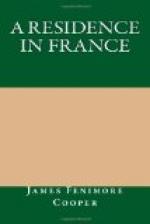Dear ——,
After a consultation with Francois, I sent the carriage to get a set of entirely new wheels, Brussels being a coach-making town, and taking a voiture de remise, we drove down to Antwerp. While the horses rested, we looked at the pictures in Malines. The “Miraculous Draught of Fishes” is thought by many to be the chef-d’oeuvre of Rubens, but, after conceding it a hardy conception and magnificent colouring, I think one finds too much of the coarse mannerism of the artist, even for such a subject. The most curious part of the study of the different schools is to observe how much all have been influenced by external objects, and how completely conventional, after all, the beau ideal of an artist necessarily becomes. It would be impossible, for one who knew the several countries, to mistake the works of Murillo, Rubens, or Raphael, for the works of artists of different schools, and this without reference to their peculiar manners, but simply as Flemings, Spaniards, and Italians. Rubens, however, is, I think, a little apt to out-Dutch the Dutch. He appears to me to have delighted in the coarse, while Raphael revelled in the pretty. But Raphael could and often did step out of himself and rise to the grand; and then he was perfect, because his grandeur was chastened.
We reached Antwerp some time before dinner. The situation of the town was singular, the Dutch holding the citadel; the place, which was peopled by their enemies, as a matter of course, lying quite at their mercy. The road from Brussels is partly commanded by them, and we saw their flag rising out of the low mounds—for in Flanders the art of fortifying consists in burrowing as deep as possible—as we approached the town. Several Dutch gun-boats were in the river, off the town, and, in the reaches of the Scheldt below, we got glimpses of divers frigates and corvettes, riding at anchor. As an offset to the works of their enemies, the Belgians had made a sort of entrenched camp, by enclosing the docks with temporary ramparts, the defences of the town aiding them, in part, in effecting their object.
One of our first visits was to the cathedral. This beautiful edifice had escaped without material damage from the recent conflicts, though the garrison of the citadel have thrown a few shots at its tower, most probably with a view to drive curious eyes out of it, the great height enabling one to get a complete bird’s-eye view of what is going on within their walls. The celebrated Rubenses were cased in massive timber to render them bomb-proof, and, of course, were invisible.




